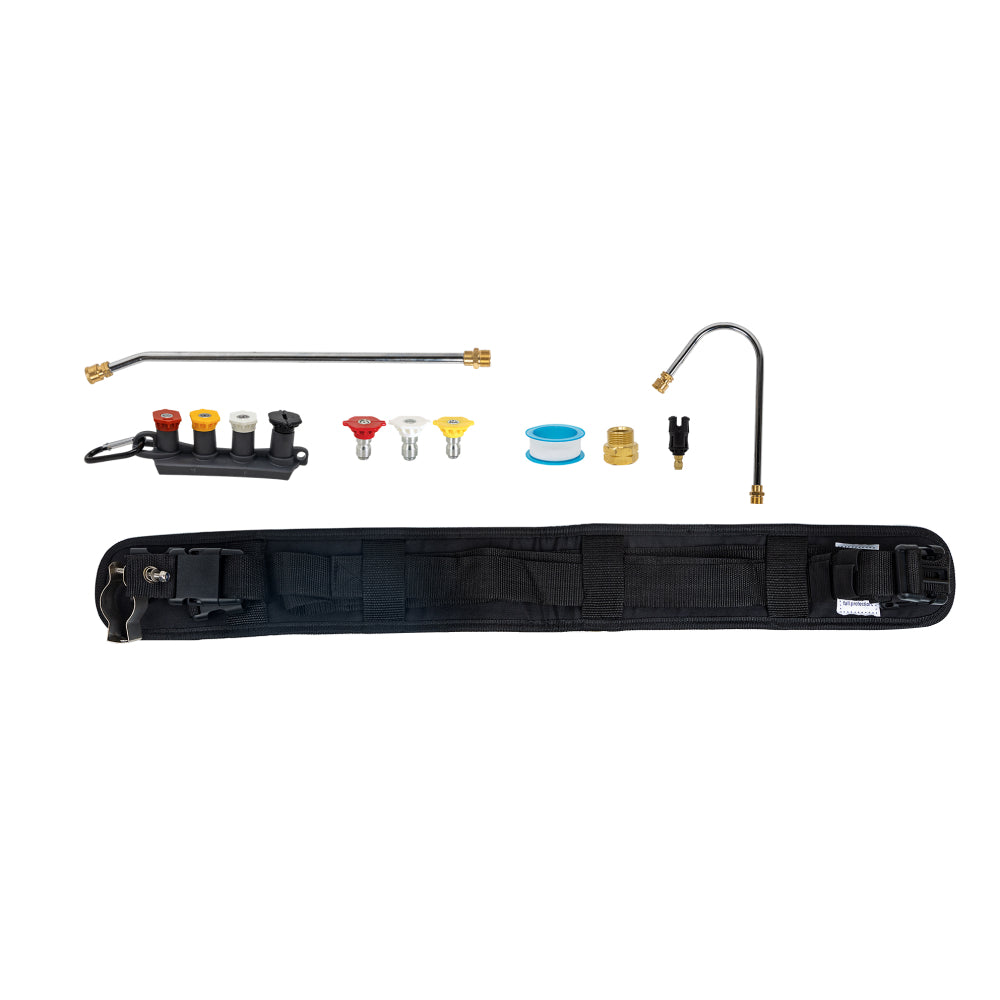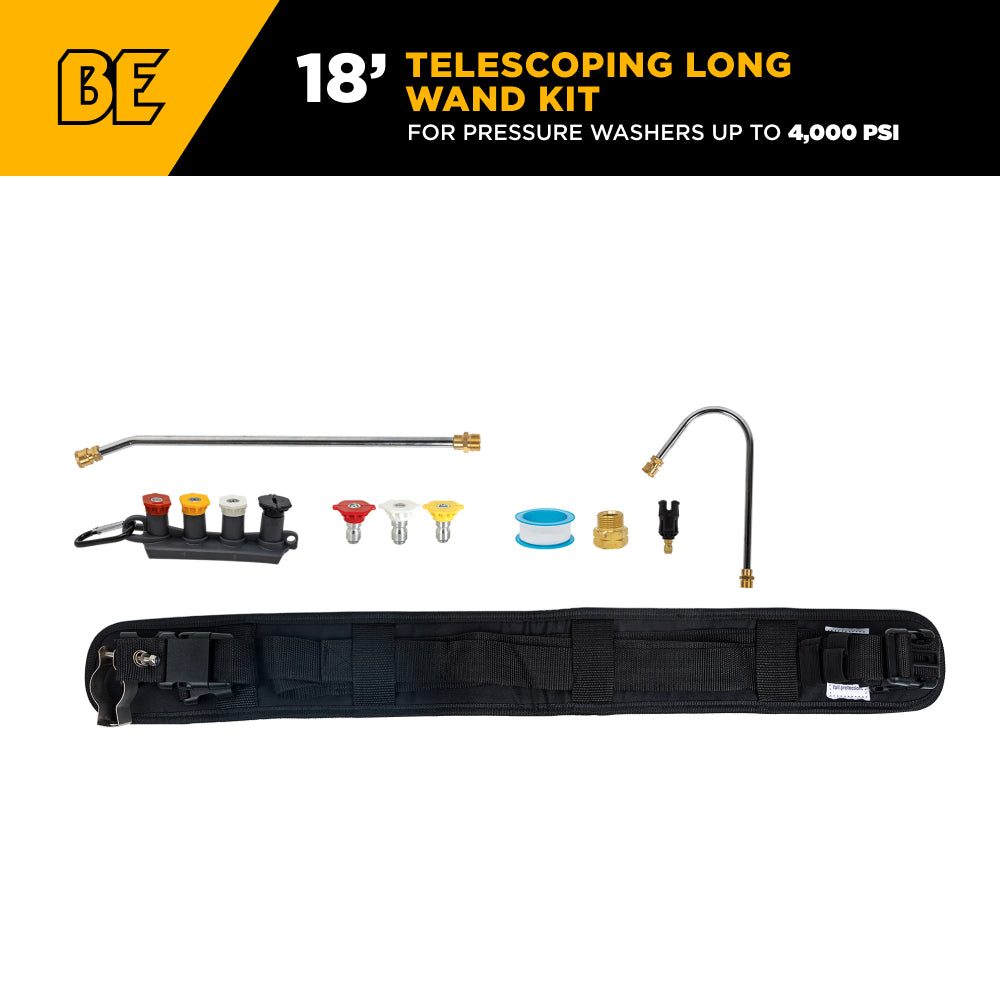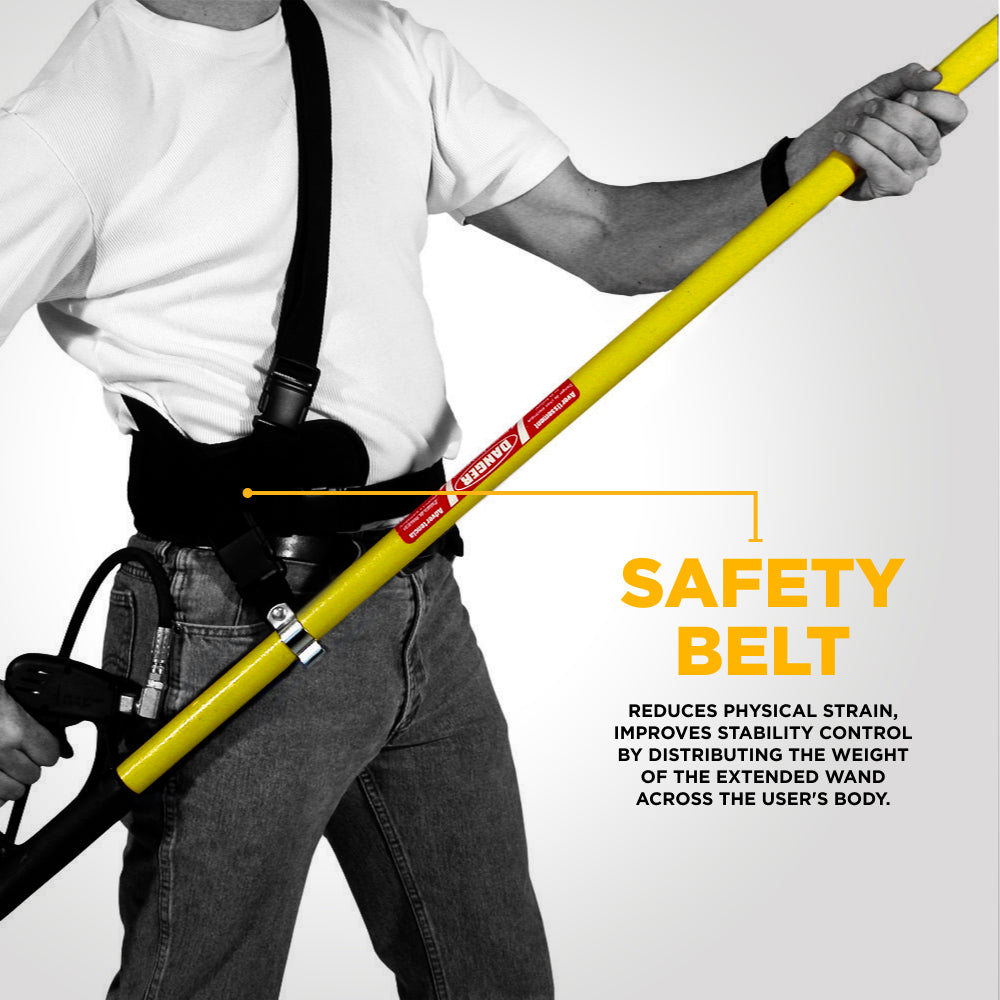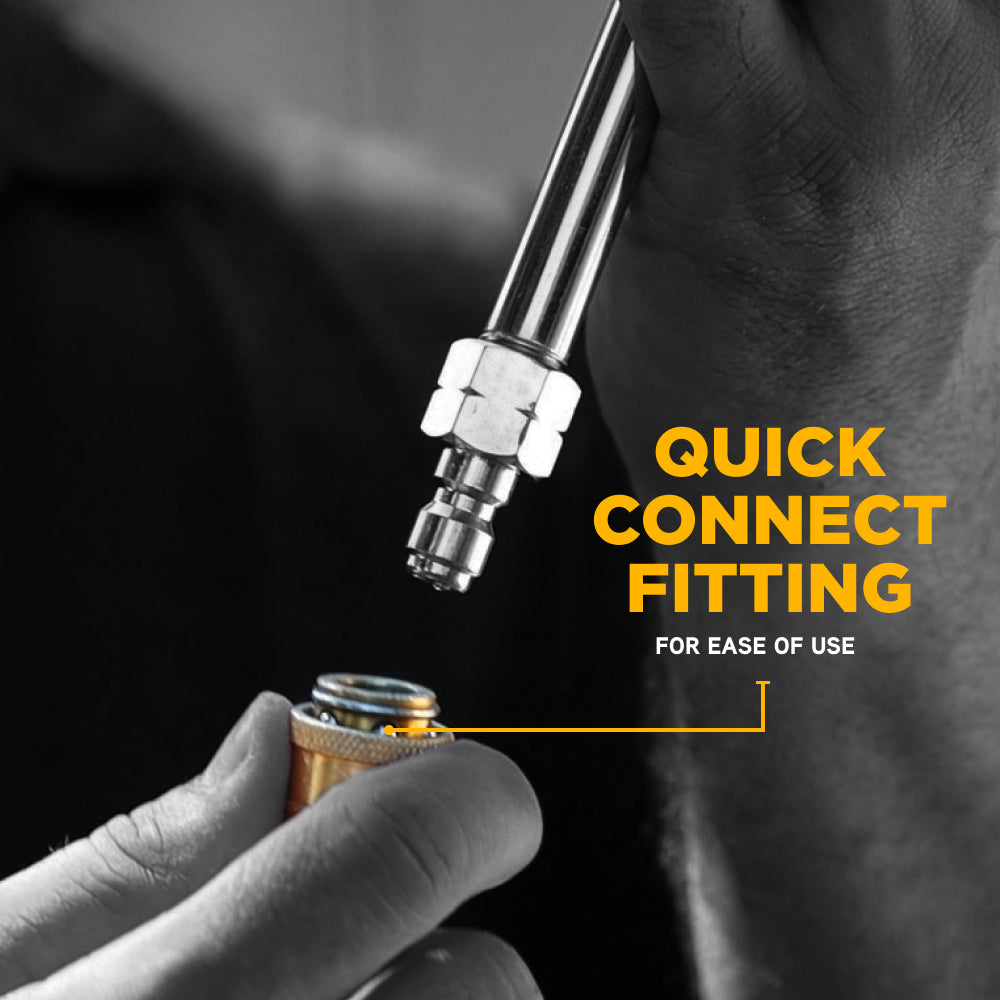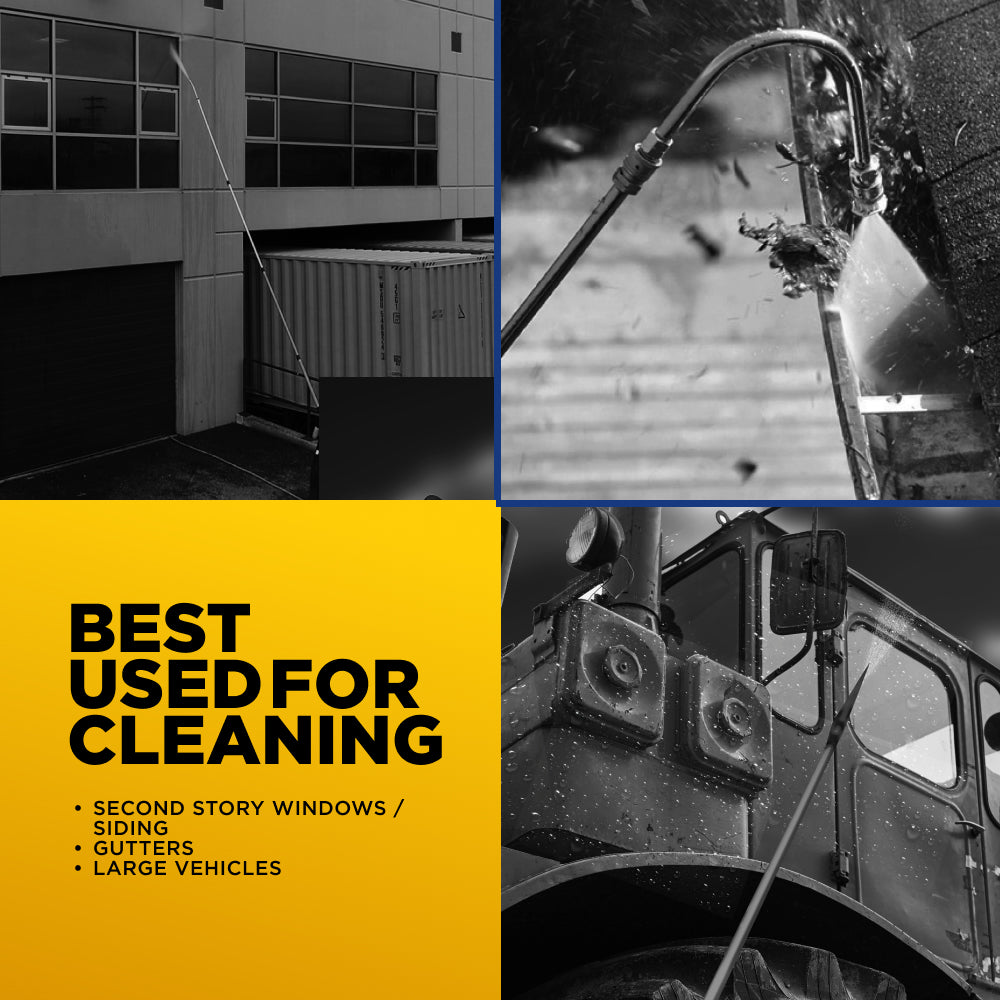PRODUCT
DESCRIPTION
Comfort and Support for Extended Pressure Washing
Using a telescoping wand gives you the reach you need to clean siding, gutters, and tall structures—but holding and balancing one for long periods can be physically demanding. That’s where the Telescoping Wand Belt Kit comes in. Designed specifically to provide extra support, stability, and comfort, this kit makes it easier to handle your telescoping wand for longer jobs without unnecessary strain.
Whether you’re a professional contractor or a homeowner tackling seasonal cleaning, this belt kit helps distribute the weight of the wand across your body, reducing fatigue in your arms and shoulders. It’s a simple, affordable solution that allows you to work smarter—not harder.
Please note: This is the belt kit only. The telescoping wand is not included.
Key Features
-
Ergonomic Support – Transfers the weight of the telescoping wand from your arms to your torso, relieving stress and fatigue.
-
Adjustable Belt System – Fits a wide range of body sizes comfortably, with easy-to-adjust straps and secure buckles.
-
Stabilizing Strap Hook – Designed to attach securely to your telescoping wand, improving control and balance during use.
-
Durable Construction – Built from rugged, high-strength materials that can handle the demands of professional or heavy-duty residential use.
-
Hands-On Comfort – Allows you to maintain steady control of the wand with less physical effort, helping you clean more effectively and safely.
Why Use a Belt Kit with a Telescoping Wand?
Telescoping wands are powerful tools for reaching high places like second- or third-story siding, tall fences, roofs, and gutters. But their extended length makes them heavy and awkward to handle for long cleaning sessions.
Without support, you’re forced to carry the entire load with your arms and shoulders, which quickly leads to fatigue. The Telescoping Wand Belt Kit takes the strain off your upper body by redistributing the weight to your core. This stabilizing effect:
-
Helps maintain a steadier spray pattern.
-
Improves precision when aiming at gutters, siding, or high surfaces.
-
Reduces the chance of arm or shoulder strain during extended use.
-
Makes tall cleaning jobs easier, faster, and safer.
Applications
The Telescoping Wand Belt Kit is the perfect companion for:
-
House Washing – Maintain steady control when spraying siding on tall homes.
-
Gutter Cleaning – Reduce fatigue when working overhead for extended periods.
-
Commercial Cleaning – Support long-duration cleaning jobs on large buildings.
-
Roof and Eave Maintenance – Gain stability when targeting hard-to-reach areas.
Built for Ease of Use
This belt kit is designed for simplicity. Just strap it on, clip the stabilizing hook to your telescoping wand, and adjust the straps until the weight feels balanced. You’ll notice the difference right away—less wobble, better control, and a more comfortable working position.
The Telescoping Wand Belt Kit is a must-have accessory for anyone who regularly uses a telescoping pressure washer wand. By redistributing the wand’s weight, it reduces fatigue, increases stability, and makes long cleaning sessions more comfortable.
Durable, adjustable, and designed for real-world use, this kit helps you get more done with less strain—whether you’re washing siding, cleaning gutters, or tackling commercial exteriors.
Note: Belt kit only. Telescoping wand sold separately.
Frequently Asked Questions about Pressure Washers
How to store a pressure washer?
To ensure the durability of your heavy duty pressure washer:
- Empty the gas tank to prevent fuel from degrading or clogging the engine.
- Empty the pump and hoses of any remaining water.
- Perform necessary maintenance before storage.
- Store in a dry area.
- Cover.
What is a pressure washer?
A power washer is a cleaning machine that uses a gasoline engine to power a high pressure water pump and nozzle. It’s used to clean driveways, decks, vehicles, outdoor furniture and more by spraying water at high PSI to remove dirt, grime, mold and other debris.Many models also come with a detergent tank for added cleaning power.
How does a power washer work?
A power washer works by drawing water from a connected hose and pumping it through a high pressure nozzle. The gas engine powers the pump which pressurizes the water and then expels it through the nozzle at high speed to clean the surface. The water pressure is measured in PSI (pounds per square inch) and the flow rate is measured in GPM (gallons per minute).Many models also feature adjustable water pressure settings to cater to different cleaning needs. BE makes pressure washing easy with models available for light jobs and heavy duty commercial cleaning projects.
Gas vs Electric power washers?
The main difference is that a gas pressure washer, known for its cleaning power, is powered by a gasoline engine, making it more powerful and portable, while an electric pressure washer is powered by electricity and is generally quieter and lighter.
Gas pressure washers are for heavy duty and large areas due to their durability, whereas electric pressure washers are for smaller jobs.
Your BE electric pressure washer is perfect for smaller jobs and built for portability, and we offer a wide range of electric models. Included with our electric models is a long extension cord for use anywhere around your house.
What to consider?
When choosing a gas pressure washer consider:
- Pressure (PSI): More PSI means more cleaning power but also more potential for damaging delicate surfaces.
- Flow Rate (GPM): More GPM means faster cleaning as more water is dispensed.
- Engine Power: Bigger engines mean more durability and power.
- Portability: Weight, handle design and wheel size for easier to move.
- Nozzles: Multiple spray nozzles to adjust the spray pattern for different tasks.
- Adjustable Nozzle: Allows for fine-tuning the spray intensity and pattern for various cleaning needs.
How much pressure do I need for?
The required pressure (PSI) and cleaning power depend on the surface you’re cleaning:
- Light duty (car washing, outdoor furniture): 1,300-1,800 PSI.
- Medium duty (patios, fences, decks): 2,000-3,000 PSI.
- Heavy duty (driveways, brick walls, large equipment): 3,000+ PSI.
Many pressure washers come with adjustable pressure settings to handle different cleaning tasks effectively.
Can a pressure washing damage surfaces?
Yes, a power washer can damage surfaces if used incorrectly. High pressure water can strip paint, dent soft surfaces or even cause structural damage if the pressure is too high or the nozzle is held too close to the surface. Always use the right PSI for the material you’re cleaning and keep a safe distance from delicate surfaces.
To prevent damage, consider using a model with adjustable pressure settings.
How to maintain your pressure washer?
To ensure the durability and smooth operation of a pressure washer:
- Change the oil as per manufacturer’s instructions.
- Clean or replace the air filter to ensure good airflow.
- Inspect and clean the nozzle regularly to prevent clogs.
- Drain the gas tank if you’re storing the washer for a long time.
- Check the hoses for leaks or damage and replace them if needed.
- Follow regular maintenance requirements to keep the washer in optimal condition.
Can I use a pressure washer in cold weather and low water temperature?
You can use a pressure washer in cold weather but it’s more difficult. The water flow rate in the hoses and pump can freeze and damage the equipment. If you plan to use your pressure washer in cold temperatures make sure to winterize it and store it in a warm area when not in use. You can also use anti-freeze solutions for pressure washers.
Some models are designed to use hot water, which can be particularly effective for cleaning in cold weather.
Do I need any accessories?
Common accessories for power washers:
- Different nozzles (0°, 15°, 25°, 40°, and soap nozzle) to adjust spray patterns.
- Extension wands for hard to reach areas.
- Surface cleaners for large flat areas like driveways and decks.
- Hose reels to store hoses neatly and prevent tangling.
- Foam cannon or detergent bottles for soap or cleaning solutions.
- Detergents for cleaning a wide variety of surfaces.







